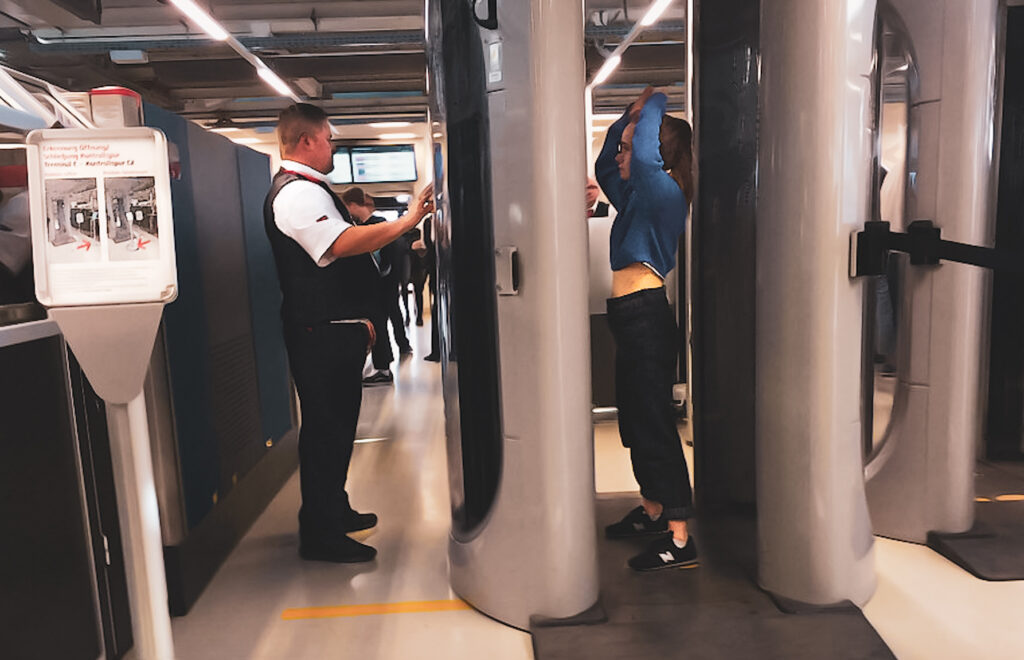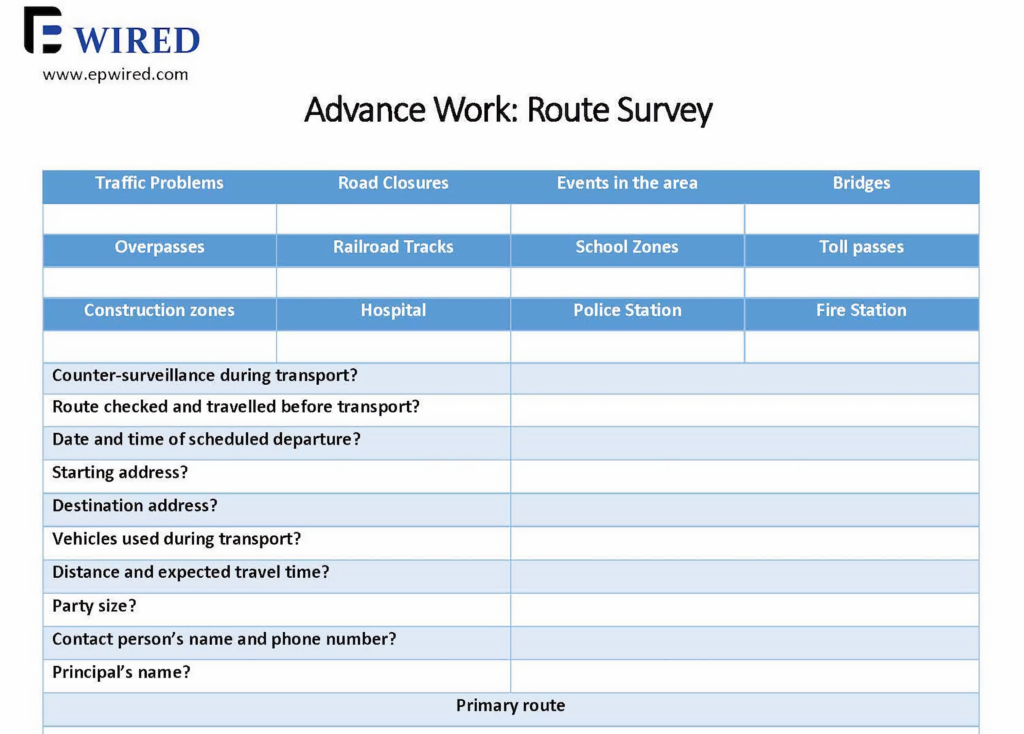An executive protection security checklist is not a substitute for on-the-ground, quick judgment. Still, checklists are a necessary aspect in any line of work. They serve as an invaluable tool to document essential details for a mission. Anytime you have a detailed checklist at hand and use it the right way, you’re ready for the trip.
Lists aren’t meant to be perfect or an answer-all, by any means. However, they need to suffice as an elementary guide or roadmap for a successful advance. That way, EP agents ensure that no vital steps are overlooked while preserving any necessary information to use during future operations.
Yes, sometimes trips happen last minute, and information needs to be gathered from the sources accessible. The data needs to be quickly analyzed and, the best plan, at least in theory, formed to execute the mission. And if you are aware of a location visit ahead of time, take the opportunity for an advance.
Great article for those starting out or early in their EP career.
Checklists can be an invaluable tool for an EP professional to ensure nothing is missed. Highly trained airline pilots use checklists all the time for the same reasons. Over time, checklists being a level of standardization to your missions. Execution checklists can also be used between on the ground EP operators and their operations centers/select stakeholders.
As the article highlights, checklists do NOT replace good judgement as there may be situations that they don’t address.
– Robert Currie, Owner & Founder, RC Advisory Services
The Purpose of Advance Checklists
EP professionals view an advance checklist like a chef views a secret recipe: you use them all the time, and you don’t share them with just anyone.
We know the stress and pressure of the job are usually high and the likelihood of overlooking essential details is significant. That is where checklists come in. So, ask yourself: What are the best practices? What kinds of safe operating procedures should we use?
Additionally, these procedural methods help to proactively enable good protection. And that is the obvious purpose of advance work: to use forward-thinking and prevent problems arising later on.
An EP specialist who has worked on a similar trip or at that location in the past may wish to work off the previous reports generated during that voyage. Being able to modify the recommended checklist to satisfy their own needs constitutes the expectation for any professional operative.
Some of the things that you may find an executive protection security checklist include:
- Principal and destination risk profiles,
- Pre- and post-security briefing checklist,
- Vehicle equipment and service evaluation, and
- Advance security checklist for hotels.
Not to mention, any good agent should be keeping up with up-to-date international trends and occurrences, so they have the ability to access correct logistical and situational threat-related information. If necessary, they may need to establish a bomb procedure that includes the ability to recognize letters and package bombs.
And there’s always something that can go wrong!
Principal Profile and Travel Brief
It’s the CPO’s job to brief the principal accordingly. After all, knowledge is power, and information is a proven weapon. When working with the protectee, you want to consider known personality traits such as the principal’s attitude, beliefs, opinions, and convictions. Are they timid or tend to attract trouble?
A biographical profile checklist may include the following:
- Special physical conditions, dietary requirements, etc.,
- Credit card numbers, names, and 24-hour phone numbers,
- A report of past threats against the principal and/or their family,
- List and location of firearms and weapons that the principal owns.
Furthermore, the most vulnerable time in a person’s life is when they’re traveling. In unknown territory, the possibility of victimization rises, which means increased preparations and advance checklists are an absolute must.
Now issues that come to mind when planning and preparing checklists are centered around probability and planning repetition. For this reason, agents need to consider possible dilemmas well in advance. Reflecting on questions like – What is the best route to get from A to B? What is the best alternative if we need it?
You can wait and guess how much time it will take to drive to a location. However, it’s better to know exactly how much time is needed to drive the route of travel, where to park the car, and who will meet you, well in advance. Planning helps you identify the best alternatives to form an ideal plan if such a thing even exists in EP.
Pre and Post Security Briefing Checklist
Pre- and post-security work help reduce exposure to liabilities. Moreover, travel abroad relies on agreed standards to reduce exposure to legal and financial issues.
Briefing objectives are a necessary part of the trip. A complete itinerary often includes:
- Participating persons,
- Dates,
- Schedules,
- Transportation information, and
- Accommodations.
Next, it’s important to review and confirm the itinerary. In addition, you may want to reconfirm the itinerary with the secretary or Chief of Staff. After all, advance planning is all about preparing and anticipating. Remember the EP adage: Anticipate, plan, and prepare.
Practice good judgment when gathering key facts, making initial contacts, and consulting files from previous trips to the location. Sometimes, agents will need to research more in-depth or concentrate on new and different materials.
Still, regardless of how good the pre-trip research is, regardless of the hours spent compiling data, if you and others can’t apply it during the actual trip with the principal, it doesn’t matter.
Quick Tip #1: EP operatives tend to travel in a suit in order to project a professional image. It may be wise to carry on a change of clothes and incidentals as carry on.
Vehicles, Equipment and Service Evaluations
If it’s the operative’s responsibility to handle the safety and care-taking of the vehicle, an evaluation checklist should be followed to the tee.
This is not an all-inclusive list but entails:
- Implement exterior scan of vehicle, hands-off,
- Inspect vehicle undercarriage,
- Search interior and trunk,
- Check fuel tank level.
Quick Tip #2: The responsibility of the driver is to maintain the vehicle’s gas tank full prior to pick up. The gas tank should never be below half of its capacity.
Rule number one when it comes to vehicle security is for an agent to be familiar with what they’re driving. If they are in fact operating the client’s transportation. There should be no surprises getting into the car.
However, accidents do happen and instances will arise when the detail will have to use their best judgment to determine the right course of action.
Advance Security Checklists for Hotels, Restaurants, Etc.
Taking the time to walk around the perimeter of the hotel to check for discernible hazards and learn the hotel is a major advantage. If possible, agents should do this prior to meeting with the staff. The principal’s visit may require special service considerations, which means a meeting with the food and lodging manager or department heads.
Pre-emptive thinking dictates having the requests printed ahead of time to show to the hospitality staff. In addition, agents prepare themselves with solutions to any objections the staff may have. And above all, it’s imperative to focus on smooth communication to help ensure operational continuity.
Remember these three basic principles when utilizing advance information:
Accessibility: The information is relevant for those who need it, where and when it’s needed.
Communication: Easy to share with others, regardless of whether on location.
Amenability: Changing, updating, or improving as research and other aspects evolve.
Think in terms of data and transparent reporting as a priority, rather than an afterthought. Most notably, following these principles enhances the executive protection security checklist, thus proving its value to both associates and clients.
The Takeaway
In a broader perspective, an executive protection security checklist is a vital part of the work EPAs conduct. Why?
Well, good data collection can be thought of as the necessary ingredient for making a protectee’s environment as secure as possible. The ultimate goal is in keeping the principal safe and productive by mitigating risk through advance planning. And ensuring operational continuity.
Our guide above highlights the many tangible aspects of security planning. Plus, check out EP Wired’s advance work templates located on our website. It communicates a comprehensive scope of what to include in your pre-mission checklist.







